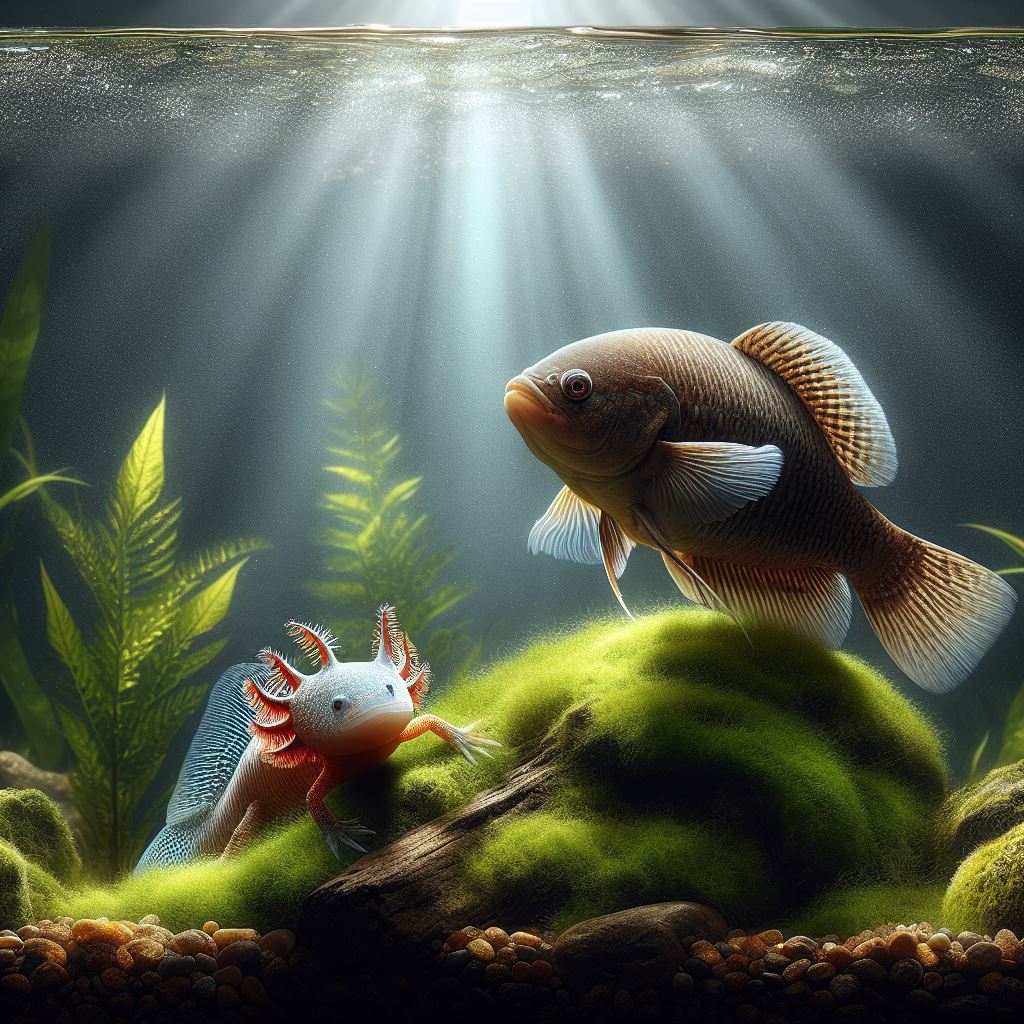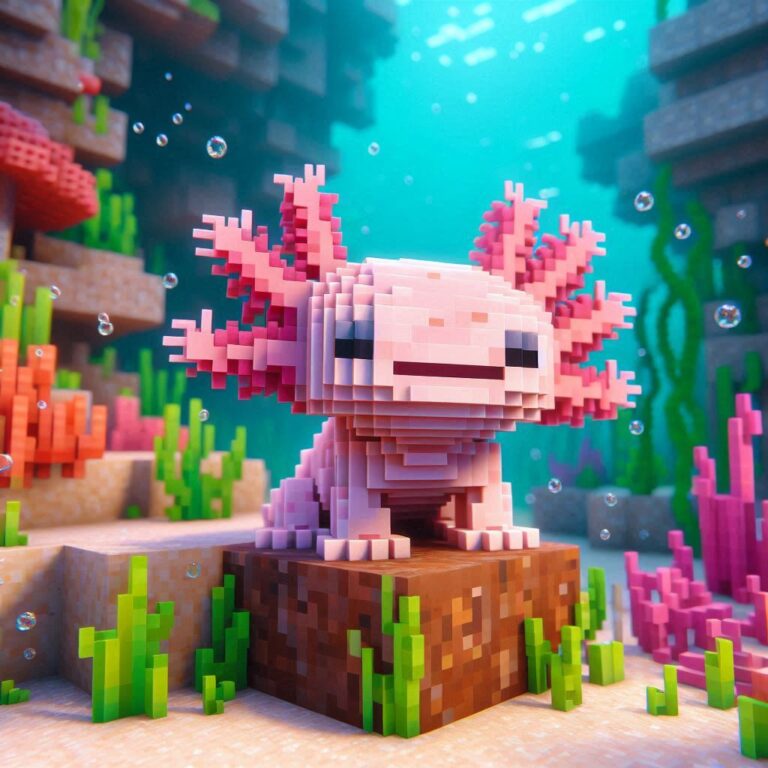
Introducing axolotls and gouramis into the same aquarium can present several challenges due to their differing habitat requirements and behaviors. Axolotls, amphibious creatures native to Mexico, prefer cooler water temperatures and minimal water flow, while gouramis, tropical freshwater fish originating from Southeast Asia, thrive in warmer water with gentle currents. Furthermore, gouramis are known to exhibit territorial and sometimes aggressive behavior, which can stress axolotls. Despite efforts to provide ample hiding spots and visual barriers, housing these species together may result in conflicts, potentially leading to injury or predation. Therefore, it’s generally advised to avoid cohabitating axolotls and gouramis to ensure the well-being of both species.
Habitat Requirements: Axolotls vs. Gouramis
Axolotls and gouramis hail from different corners of the globe, each with its own set of habitat preferences. Axolotls, often referred to as “Mexican walking fish,” originate from the ancient lakes of Xochimilco and Chalco in Mexico. These unique creatures thrive in cool, still waters, preferring temperatures between 60 to 68°F (15 to 20°C). Their natural habitat includes muddy bottoms and plenty of vegetation for shelter. On the other hand, gouramis are tropical freshwater fish found in the lush waters of Southeast Asia. They prefer warmer temperatures ranging from 72 to 82°F (22 to 28°C) and are typically found in slow-moving rivers, ponds, and flooded forests. Creating a shared habitat that meets the needs of both species can be challenging due to their contrasting temperature and water flow requirements.
Tank Size and Setup
When considering tank size and setup for housing axolotls and gouramis together, it’s essential to prioritize space and compatibility. Axolotls, known for their large size and active nature, require spacious accommodations to thrive. A tank size of at least 20 gallons per axolotl is recommended to provide ample swimming space and minimize stress. Additionally, axolotls are notorious for being messy eaters, so adequate filtration and regular water changes are crucial to maintain water quality. Gouramis, while smaller in size, still require sufficient space to swim and explore. A tank size of 20 to 30 gallons is suitable for a small group of gouramis, depending on the species and their social dynamics. Creating distinct areas with plants, driftwood, and caves can help mitigate territorial disputes and provide enrichment for both species.
Filtration Needs
Proper filtration is paramount when housing axolotls and gouramis together, as both species are sensitive to water quality issues. Axolotls produce a significant amount of waste, leading to rapid deterioration of water conditions if not adequately filtered. A combination of mechanical, biological, and chemical filtration is recommended to remove debris, ammonia, and nitrites from the water. Canister filters or sponge filters are ideal choices for axolotl tanks, providing efficient filtration without creating strong currents that may stress the axolotls. Gouramis, being sensitive to water flow, also benefit from gentle filtration methods that maintain a calm water surface. Regular maintenance, including filter cleaning and water testing, is essential to ensure a healthy environment for both species.
Substrate Considerations
Choosing the right substrate is crucial for creating a suitable environment for axolotls and gouramis. Axolotls, with their bottom-dwelling nature, prefer soft substrates that won’t cause injury to their delicate underbellies. Fine sand or smooth gravel is ideal for axolotl tanks, providing a comfortable surface for them to explore and burrow. Avoid sharp or abrasive substrates that may scratch or injure the axolotls’ skin. In contrast, gouramis are less particular about substrate type but may benefit from a sandy or gravel substrate to forage for food and build nests, depending on the species. Live plants can also be incorporated into the substrate to provide natural filtration and enrichment for both species, but be mindful of axolotls’ tendency to uproot plants in their search for food. Overall, selecting a substrate that balances the needs of both axolotls and gouramis is essential for creating a harmonious aquatic habitat.
Gouramis Behavior: How It Affects Axolotls
Understanding the behavior of gouramis is essential when considering their compatibility with axolotls. Gouramis are known for their diverse behaviors, ranging from peaceful to aggressive, depending on the species and individual temperament. Some species, like the peaceful dwarf gouramis, coexist well with other community fish, while others, such as the territorial paradise fish, can be more aggressive, especially during breeding season. This variation in behavior can directly impact axolotls sharing the same tank. Aggressive gouramis may harass or intimidate axolotls, causing stress and potentially leading to injury. Additionally, gouramis’ tendency to establish territories and defend them vigorously can disrupt the typically calm and docile nature of axolotls. Therefore, careful consideration of gouramis’ behavior is crucial when determining their compatibility with axolotls.
Aggression Levels
Gouramis exhibit a wide range of aggression levels, influenced by factors such as species, gender, and tank conditions. Male gouramis, in particular, may display territorial behavior, especially during breeding season when they become more aggressive in defending their nests. This aggression can manifest in chasing, fin-nipping, and even physical confrontation with tankmates, including axolotls. Female gouramis, while generally less aggressive, may also display territorial behavior if they feel threatened or stressed. Tank size and setup play a significant role in mitigating aggression levels, as ample space and hiding spots can reduce competition and minimize conflicts between gouramis and axolotls. Additionally, providing a well-structured environment with plenty of visual barriers can help diffuse tension and create a more harmonious tank dynamic.
Compatibility with Axolotls
Determining the compatibility of gouramis with axolotls requires careful observation of their behaviors and interactions in the aquarium. While some gourami species may coexist peacefully with axolotls, others may pose a risk due to their aggressive tendencies. It’s essential to research the specific species of gourami being considered and assess its compatibility with axolotls based on factors such as temperament, size, and activity level. Additionally, introducing gouramis and axolotls gradually and monitoring their interactions closely can help gauge their compatibility and identify any potential issues before they escalate.
Social Dynamics in the Tank
Creating a harmonious social dynamic in a tank shared by gouramis and axolotls requires careful consideration of their individual behaviors and needs. Gouramis are social fish that thrive in groups, with some species forming hierarchical structures within their schools. This social behavior can impact axolotls, as gouramis may exhibit dominance behaviors such as chasing or territorial disputes. Providing ample hiding spots, plants, and other visual barriers can help alleviate social stress and provide refuge for both species. Additionally, maintaining a diverse tank environment with plenty of hiding spots and enrichment opportunities can encourage natural behaviors and reduce competition among tankmates. Regular observation and intervention, if necessary, are essential for maintaining a peaceful social dynamic and ensuring the well-being of both gouramis and axolotls in the aquarium.
Dietary Differences Between Axolotls and Gouramis
Axolotls and gouramis have distinct dietary needs due to their evolutionary backgrounds and physiological differences. Axolotls, being amphibians, are carnivorous creatures that primarily feed on live prey such as small fish, worms, and aquatic insects. Their diet is rich in protein and fat, which is essential for their growth and maintenance. On the other hand, gouramis are omnivorous fish that require a varied diet consisting of plant matter, insects, and small crustaceans. Their nutritional requirements include a balance of protein, carbohydrates, vitamins, and minerals to support their metabolism and overall health. Understanding these dietary differences is crucial for providing appropriate nutrition to both axolotls and gouramis in a shared aquarium setting.
Axolotl Feeding Habits
Axolotls are voracious eaters known for their enthusiastic feeding behavior. They use their keen sense of smell and sensitive lateral line system to detect prey, capturing it with their quick strikes and powerful jaws. In captivity, axolotls readily accept a variety of live and frozen foods, including bloodworms, brine shrimp, and earthworms. It’s essential to offer a diverse diet to ensure they receive all the essential nutrients they need to thrive. Additionally, feeding should be done in moderation to prevent overfeeding and maintain water quality in the tank.
Gourami Dietary Needs
Gouramis, being omnivorous, have a more varied diet compared to axolotls. They feed on a combination of plant matter, insects, algae, and small invertebrates in their natural habitat. In captivity, gouramis can be fed a diet consisting of high-quality commercial flakes or pellets supplemented with live or frozen foods such as bloodworms, brine shrimp, and daphnia. It’s essential to provide a balanced diet that meets their nutritional requirements, including protein, fiber, vitamins, and minerals. Additionally, offering a variety of foods can help stimulate their natural foraging behavior and prevent dietary deficiencies.
Ensuring Proper Nutrition for Both Species
Maintaining proper nutrition for both axolotls and gouramis requires careful planning and attention to their dietary needs. It’s essential to offer a variety of foods that cater to the specific requirements of each species, ensuring they receive all the essential nutrients they need to stay healthy. Regularly assessing their feeding behavior and body condition can help determine if any adjustments need to be made to their diet. Additionally, monitoring water quality and conducting regular water changes are crucial for removing excess waste and maintaining a clean and healthy environment for both axolotls and gouramis to thrive. By providing appropriate nutrition and environmental conditions, aquarists can ensure the well-being and longevity of both species in their aquarium.
Potential Risks of Housing Axolotls and Gouramis Together
While the idea of creating a diverse and vibrant aquatic community is appealing, housing axolotls and gouramis together presents several potential risks that aquarists should carefully consider. These risks stem from differences in habitat requirements, behavior, and dietary preferences between the two species. Understanding and mitigating these risks is essential to ensure the well-being of both axolotls and gouramis in a shared aquarium environment.
Disease Transmission
One of the primary concerns when housing axolotls and gouramis together is the risk of disease transmission between the two species. Both axolotls and gouramis are susceptible to various aquatic diseases, including bacterial, fungal, and parasitic infections. Sharing the same water environment increases the likelihood of disease transmission, especially if one species becomes infected. Quarantining new additions and maintaining excellent water quality through regular testing and maintenance can help reduce the risk of disease outbreaks and ensure the health of both axolotls and gouramis.
Competition for Food and Space
Another potential risk of cohabitating axolotls and gouramis is competition for food and space. Axolotls are carnivorous predators that require live prey or meaty foods to thrive, while gouramis are omnivores that consume a variety of plant matter, insects, and small invertebrates. Differences in feeding habits and dietary preferences can lead to competition for food resources in the aquarium. Additionally, both species may vie for territory and hiding spots, especially if space is limited. Providing ample hiding spots, plants, and visual barriers can help reduce competition and aggression between axolotls and gouramis in the tank.
Injury Due to Mismatches in Size or Behavior
Mismatched sizes and behaviors between axolotls and gouramis can also pose a risk of injury in a shared aquarium environment. Axolotls, with their large size and clumsy movements, may inadvertently injure smaller or more delicate gouramis during feeding or exploration. Conversely, aggressive or territorial gouramis may harass or nip at axolotls, causing stress and potential injury. Monitoring their interactions closely and providing adequate space and hiding spots can help minimize the risk of physical harm between the two species. Additionally, choosing tankmates with similar size and temperament can reduce the likelihood of conflicts and injuries in the aquarium.
Temperature and Water Quality Considerations

Maintaining optimal temperature and water quality is paramount when housing axolotls and gouramis together, as both species have specific environmental requirements for health and well-being. Temperature plays a crucial role in regulating metabolic functions and overall physiology in aquatic animals. Axolotls prefer cooler water temperatures ranging from 60 to 68°F (15 to 20°C), while gouramis thrive in warmer waters between 72 to 82°F (22 to 28°C). Balancing these temperature preferences can be challenging but essential for creating a harmonious environment for both species. Additionally, maintaining proper water quality parameters, including pH, ammonia, nitrite, and nitrate levels, is essential for ensuring the health and vitality of axolotls and gouramis. Regular water testing and monitoring, along with adequate filtration and water changes, are necessary to maintain stable water parameters and prevent fluctuations that can stress or harm aquatic life.
Optimal Temperature Ranges
Understanding the optimal temperature ranges for axolotls and gouramis is crucial for creating a suitable habitat in a shared aquarium environment. Axolotls, being amphibians, prefer cooler water temperatures typically found in their native habitat in the highland lakes of Mexico. Water temperatures between 60 to 68°F (15 to 20°C) are ideal for axolotls, as temperatures outside this range can stress or compromise their immune system. Gouramis, on the other hand, are tropical fish native to Southeast Asia, where they inhabit warm, tropical waters. Optimal temperature ranges for gouramis range from 72 to 82°F (22 to 28°C), with some species tolerating slightly higher temperatures. Maintaining stable temperatures within these ranges is essential for promoting the health, growth, and natural behaviors of both axolotls and gouramis in the aquarium.
pH and Water Hardness Requirements
In addition to temperature, pH and water hardness are critical factors to consider when creating a suitable habitat for axolotls and gouramis. Axolotls prefer slightly alkaline water with a pH range of 7.4 to 8.0 and moderate water hardness levels. In contrast, gouramis thrive in slightly acidic to neutral water with a pH range of 6.0 to 7.5 and soft to moderately hard water. Balancing these pH and water hardness requirements can be challenging in a shared aquarium but is essential for promoting optimal health and physiological function in both species. Utilizing natural buffers and additives, such as crushed coral or driftwood, can help stabilize pH and water hardness levels and create a suitable environment for axolotls and gouramis.
Monitoring Water Parameters for Both Species’ Needs
Regular monitoring of water parameters is essential for ensuring the health and well-being of axolotls and gouramis in a shared aquarium environment. Monitoring pH, ammonia, nitrite, nitrate, and temperature levels should be conducted regularly using reliable test kits to detect any fluctuations or imbalances that may arise. Axolotls are particularly sensitive to water quality issues, with high ammonia or nitrite levels posing a significant risk to their health. Gouramis are also sensitive to poor water quality, especially fluctuations in pH and temperature. Maintaining stable water parameters within the optimal ranges for both species is crucial for preventing stress, disease, and potential mortality. Additionally, performing regular water changes, cleaning filters, and maintaining proper filtration are essential for promoting a healthy aquatic ecosystem and ensuring the longevity of axolotls and gouramis in the aquarium.
FAQs
Q. Can Axolotls and Gouramis live together peacefully?
A. It’s not advisable due to differing habitat and behavioral needs. Gouramis may stress axolotls, and there’s a risk of injury or predation.
Q. Do Axolotls eat Gouramis?
A. While axolotls typically feed on smaller prey like fish, they may try to consume gouramis if given the opportunity, especially if the gouramis are small.
Q. What size tank do I need for housing Axolotls and Gouramis together?
A. A large tank is necessary to accommodate both species comfortably. Aim for a tank size of at least 40 gallons or larger to provide ample space and minimize territorial disputes.
Q. Can Axolotls and Gouramis share the same water parameters?
A. Axolotls prefer cooler water with minimal flow, while gouramis thrive in warmer water with gentle currents. Balancing these preferences can be challenging and may require compromise.
Q. How do I prevent aggression between Axolotls and Gouramis?
A. Providing plenty of hiding spots and visual barriers can help reduce aggression. However, it’s best to avoid mixing these species altogether to prevent stress and potential harm.
Q. Are there any diseases that Axolotls and Gouramis can transmit to each other?
A. Yes, both species are susceptible to various aquatic diseases, and housing them together increases the risk of disease transmission. Quarantining new additions and maintaining excellent water quality can help mitigate this risk.
Q. Can I feed Axolotl food to Gouramis and vice versa?
A. While some foods may overlap, such as certain types of frozen or live foods, it’s essential to ensure each species receives a balanced diet tailored to its specific nutritional needs.
Q. How do I acclimate Axolotls and Gouramis to each other’s presence?
A. Introduce them slowly over time, starting with short periods of exposure and gradually increasing the duration. Monitor their behavior closely for signs of stress or aggression.
Q. What signs indicate that Axolotls and Gouramis are not compatible?
A. Aggressive behavior, fin nipping, or stress-related behaviors like hiding or loss of appetite are indicators that the species may not be compatible and should be separated.
Q. Can I keep Axolotls and Gouramis together temporarily?
A. It’s not recommended, as temporary arrangements can still lead to stress and potential conflicts. It’s best to house them separately to ensure the well-being of both species.
Conclusion
In conclusion, while the idea of housing axolotls and gouramis together may seem appealing, it’s essential to recognize and address the potential risks and challenges associated with this arrangement. From differences in habitat requirements and dietary preferences to variations in behavior and environmental needs, creating a harmonious environment for both species requires careful planning, observation, and maintenance. By understanding and accommodating the unique needs of axolotls and gouramis, aquarists can create a thriving aquatic community where both species can coexist peacefully.

Hassan Shah carries over four years of hands-on expertise in caring for axolotls, guided by his cherished companion ‘Little Bruno,’ a thriving axolotl under his attentive care for three years.



